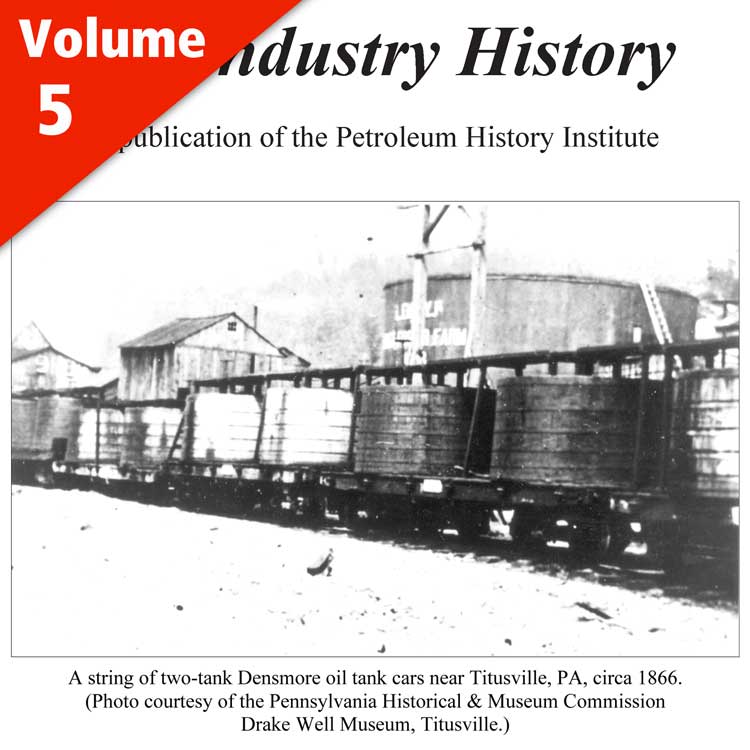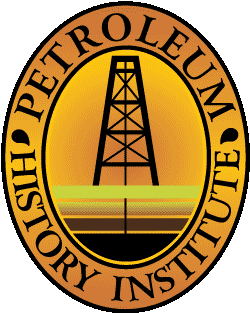
This Issue was Funded in Part by a Grant from: Helmer Rabild Charitable Trust (Erie, PA)
Editorial and Mount Morgan,
The Densmore Brothers and America’s First Successful Railway Oil Tank Car, 1865,
Early Petroleum Discoveries in Washington County, Pennsylvania,
A Short History of Synthetics,
Alaska’s Richest Day: The Prudoe Bay Lease Sale That Brought $900 Million to the 49th State,
Hackberry Dome, Louisiana: Persistence in the Early Days of South Louisiana Exploration,
Editor’s Note – Recollections,
Shell and the Salem – The Largest Marine Fraud in History,
Early Off-Shore Seismic Exploration,
10 Cents A Gallon! Gasoline Station Work, 1937-1940,
Abstracts – Shreveport Symposium March 26-29, 2003
Errata
Volume 5 Abstracts
The Densmore Brothers and America’s First Successful Railway Oil Tank Car, 1865
Samuel T. Pees
Petroleum Geologist, 628 Arch Street, Suite A-104, Meadville, PA 16335
Richard Senges, C.P.M.
1231 Wellington Drive, Victor, NY 14564
ABSTRACT: The first practical railway tank cars in America went into service in 1865 following a successful run in late summer from a terminal at Miller Farm on Oil Creek, Pennsylvania, to New York. James Densmore and his brother Amos Densmore, both of the Densmore Oil Company, an oil producing, oil buying and shipping firm on Oil Creek, are credited as the inventors, and their names with a Meadville, Pennsylvania, address appear on the letters patent. They obtained the use of a flat car from the Atlantic and Great Western Railroad and mounted two round wooden tanks on it, each one over the trucks. The tight tanks were built of pine planks and each held 40 to 45 barrels of crude oil. James Densmore saw to the building and procurement of the tank cars. A partner, Watson & Co., bought oil for shipment and handled loading. Oil was shipped by the Densmore, Watson & Company to Clint Roudebush & Co. in New York City on a steady basis. Other shippers followed the design and a vast commerce of crude oil and refined products in bulk resulted from this invention.
The Densmore two-tank design was patented tardily on April 10, 1866. Many of those cars were already on the tracks before that date as well as similar cars built by others. Patents for protection purposes were also obtained on June 26, 1866, for designs having a single round tank, three round tanks and one, two or three rectangular or square tanks, but the cars with two round wooden tanks remained the most common. The patents stated that light riveted sheet iron could also serve. However, pine wood, being in plentiful supply, was preferred. The Densmore cars were gradually replaced by horizontal boiler-type iron tank cars beginning 1868-69. Some of the wooden tank cars lingered on into the early 1870’s.
Early Petroleum Discoveries in Washington County, Pennsylvania
Kristin M. Carter, P.G.
Pennsylvania Department of Conservation and Natural Resources
Bureau of Topographic and Geologic Survey, Oil, Gas, and Subsurface Geological Services
400 Waterfront Drive, Pittsburgh, PA 15222-4745
ABSTRACT: Pennsylvania has a rich history of petroleum production, thanks in large part to “Colonel” Edwin L. Drake. Drake’s discovery of shallow oil in Titusville in August 1859 gained recognition for Pennsylvania and spawned the modern petroleum industry. Drake’s discovery encouraged petroleum exploration throughout western Pennsylvania, including Washington County in the southwestern corner of the state. In the early 1880s, natural gas was discovered in northwestern Washington County, and by 1885, petroleum exploration efforts in and around the city of Washington discovered two, new, oil-producing horizons, named the Gantz and Gordon sands, associated with the Upper Devonian Venango Group. Little is left of these early petroleum wells, but through the use of historical maps and well records dating from the late 1800s through early 1900s, several locations have been documented throughout Washington County.
A Short History of Synthetics
Herman K. Trabish, D.C.
2763 Mary Street, La Crescenta, CA 91214
ABSTRACT: From the earliest impulses of western science to create something from something else, the malleability of hydrocarbon raw materials (petroleum, natural gas and coal) has been the focus of experiment and accidental discovery. Early efforts to develop synthetic pharmaceuticals inadvertently led to the artificial dye industry. The pursuit of the ideal artificial billiard ball led to a greater understanding of petrochemicals and thereby to celluloid for the emerging photographic industry. Moldable manufactured goods of all kinds found markets. Chemists improved their methods. The marketplace often drove the process: As electricity lit up civilization, its wiring needed affordable insulation. In peacetime expansions, and even during the Great Depression, the marketplace was the showcase of the new and remarkable consumer goods and industrial components. The world wars heightened demand. Shortages of natural commodities, especially during World War II, drove the industry. After the extraordinary expansion following World War II, a backlash developed. It began with concerns about human’s capacity to cohabit healthfully and safely with the synthetics. Eventually questions arose about the natural environment=s tolerance for the synthetic. In the last two decades, industry has begun to develop materials people can live with and methods to help the environment digest them.
Alaska’s Richest Day: The Prudoe Bay Lease Sale That Brought $900 Million to the 49th State
Ross A. Coen
Department of Northern Studies
University of Alaska Fairbanks, P.O. Box 756460, Fairbanks, AK 99775-6460
ABSTRACT: Eighteen months after the discovery of the Prudhoe Bay (Alaska) oil field in early 1968, the state of Alaska held an oil and gas lease sale and offered for competitive bid nearly half a million acres of the oil-rich North Slope. The state received bids from many of the world’s largest oil companies, and in a single day took in just over $900 million in lease revenue. The sale did much more than fill state coffers with unimaginable amounts of money, however, for it forced Alaskans, largely for the first time, to consider both their state’s future as a major oil producer and the manner in which they would deal with the many social and political issues that accompanied this sudden windfall. This paper discusses the convergence of these issues in the context of the Prudhoe Bay lease sale, which stands as an historical marker for Alaska’s entry into the realm of major oil producing states.
Hackberry Dome, Louisiana: Persistence in the Early Days of South Louisiana Exploration
Jeff A. Spencer
Osprey Petroleum Company, 15995 N. Barker’s Landing, Suite 350, Houston TX 77079
ABSTRACT: With the Spindletop discovery near Beaumont, Texas in 1901, followed by the Jennings, Louisiana discovery ten months later, South Louisiana quickly became a focus of oil exploration activity. Although commercial oil production at Hackberry Dome wasn’t established until 1927, the many drilling attempts in the area are a tribute to the persistence of the early wildcatters. Approximately 50 dry holes were drilled at Hackberry from the late 1890s until the field’s discovery. Over 1000 wells have been drilled in the West and East Hackberry fields, with a cumulative production of 265 MMBO and 263 BCFG. The field has been the site of two joint industry-U.S. Department of Energy (DOE) enhanced oil recovery projects and has been evaluated with a 1995 3D seismic survey. The dome is also the site of one of the nation’s Strategic Petroleum Reserves.
Gilbert D. Harris (1864-1952): Cornell Professor, Louisiana State Geologist, and Long Distant Oil Consultant
William R. Brice
Geology & Planetary Science, University of Pittsburgh at Johnstown, Johnstown, PA 15904
ABSTRACT: Gilbert Dennison Harris, a native of Jamestown, New York, was State Geologist for Louisiana from 1899 until 1909, while also on the faculty at Cornell University. He spent each winter in Louisiana and taught at Cornell in the fall and summer; an arrangement which allowed students from Cornell and Louisiana State University work experience opportunities. The oil industry in this part of the world was in its infancy when Harris began his work with the Louisiana survey, and Harris and his survey teams provided the geological foundation, including their recognition of dome structures in the state, which was central to many later discoveries of oil and gas. As the State Geologist, Harris constantly received requests for assistance with various drilling projects and he considered becoming a private consultant. When the Survey lost its funding in 1909, Harris was free to pursue his role as a private consultant while maintaining his faculty position at Cornell. Drilling would continue in Louisiana even while Harris was in New York and then he did his consulting by telegram and letter. He would receive letters directly from the foreman at the well, including actual well cuttings and their depths, requesting instructions. After examining the cuttings, Harris would telegraph or mail his answers back to the driller. One wonders how much lost time there was on the rig while the crew waited for the mail to be delivered. But this method was successful and Harris remained a popular consultant in the oil industry for many years.
Shell and the Salem – The Largest Marine Fraud in History
Basil South
ABSTRACT: In 1980 the supertanker Salem was reported lost off the coast of Senegal, but subsequently it was discovered that though the ship was lost, not all the cargo went down with it. Most of the oil had been unloaded in South Africa, in possible violation of the embargo against the South African Government at that time. This is the story of my involvement with the investigation of the saga of the Salem and her cargo.
Early Off-Shore Seismic Exploration
Sidney Kaufman
651 Bering Drive #605; Houston, TX 77057
ABSTRACT: This description of off-shore seismic exploration is excerpted from an interview conducted with the author in June, 2003, at the Department of Earth and Atmospheric Sciences at Cornell University. Dr. Kaufman was working with the Shell Oil Company at the time he was doing this work. Participating in the interview with Dr. Kaufman from the Department were Dr. Muawia Barazangi, Senior Scientist; Mr. Steven Gallo, Computer Operations Manager; Mr. George Hade, Research Support Specialist, II (retired); Dr. William Brice, the unofficial Department historian; Carrie Brindisii, and William Langin. More details of the interview can be obtained from the Department’s web site.
10 Cents A Gallon! Gasoline Station Work, 1937-1940
B.J. Smith
AAA-East Central, 19023 Park Avenue Plaza, Meadville, PA 16335
ABSTRACT: Working at a service station in my teens wasn’t only about gasoline. Commissions on oil changes, grease jobs, wiper blades, tires, headlight bulbs and other accessories upped my weekly take from a base salary of $5.00 to $17.00 in good times. I found that there was adventure in salesmanship even at the service station level of the oil industry. Yes, we cleaned windshields, gauged tire pressure, promoted certain motor oils and talked up products while doing it. A nickel commission was an incentive in those days.
